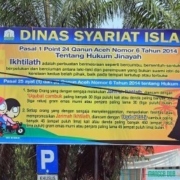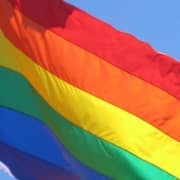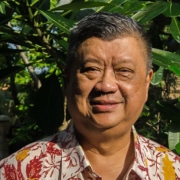
The Indonesian Broadcasting Commission (KPI) has long played the role of moral police in the media, and gender and sexuality are often the easiest targets. Photo by Flickr user Ikhlasul Amal.
The Indonesian Broadcasting Commission (KPI) added its voice to the chorus of condemnation of lesbian, gay, bisexual and transgender (LGBT) Indonesians in February, issuing a circular banning men from wearing feminine (kewanitaan) clothing and makeup, or exhibiting effeminate body language or speech. KPI claimed that these restrictions were necessary to safeguard Indonesian norms and morality, as well as to protect Indonesian children. But whose norms and morality is KPI defending? Which children does KPI protect, and from what threat?
The KPI justified the circular by referring to Article 9, 15 (1), and 37 (4a) of its 2012 Broadcasting Program Standards (SPS). But a closer look at the KPI standards indicates that the institution has quite deliberately adopted a conservative interpretation. Articles 15 (1b and 2) and 17 (1 and 2b) of the Broadcasting Code of Conduct (P3) and Article 21 of the Broadcasting Program Standards (SPS), all discuss protecting the rights of people with different sexual orientation and gender identities in the media. Article 9 of the SPS, meanwhile, reads:
- Broadcast programs must consider the norms of decency and morality upheld by diverse audiences regarding religion, ethnicity, culture, age, and/or economic background.
- Broadcast programs should be careful not to harm and cause a negative impact on the diversity of norms of decency and morality embraced by the community.
This article clearly refers to respect for the diversity of norms embraced by the community. Indonesian performing arts and culture contains many diverse expressions of gender and sexuality, such as reog Sunda in West Java, arja in Bali, lengger lanang in Central Java, or ludruk in East Java. Similarly, most Indonesians are familiar with the greatly admired cross-dressing dancer, Didik Ninik Towok.
Transgender and cross-dressing performers have also been a prominent part of Indonesian popular culture for many years. Indonesians around my age grew up with transgender comedians and performers like Kabul Basuki (“Tessy”), Tata Dado, Ade Juwita, and Dorce Gamalama. How then, can KPI claim that broadcasting material of men displaying feminine attributes contravenes community norms of decency and morality?
In issuing the circular, the KPI is seeking to entrench idealised gender norms and impose a singular version of morality on all Indonesians. But in doing so, it discriminates against the Indonesian communities and traditions that embrace diverse expressions of gender.
KPI has long played the role of moral police in the media, and gender and sexuality are often the easiest targets. Notably, one of its commissioners was heavily involved in the formulation of the anti-pornography bill, and continues to be a vocal anti-pornography activist. KPI’s idealised gender order is based on a conservative interpretation of the major religions in Indonesia, especially Islam. On its website, KPI claims that its circular was issued in accordance with the views of three major Islamic institutions in Indonesia: the Indonesian Council of Ulama (MUI), Nahdlatul Ulama, and Muhammadiyah. In mainstream Islamic teaching, there is a strict boundary between what is appropriate for men and women.
Historically, the New Order government regulated gender and sexuality based on heteronormative family principles influenced by Islamic norms. Gender was seen as predetermined and unchangeable and any variations were abnormal and immoral. The heteronormative family was the pillar of the nation, a concept enshrined in the 1974 Marriage Law. Men were depicted as leaders and, as providers for the family, had to be economically productive. Women, as housewives, were required to raise children and support their husbands’ careers. Women were also responsible for guarding the morality and wellbeing of their broader community. Disruptions to this heteronormative family ideal were seen as a threat to the stability of the nation.
It has been much more difficult to uphold such rigid gender constructions in the democratic era, when citizens have access to vast amounts of information online and are much freer to express alternate views. Progressive women’s groups have worked not just to empower women, but have also encouraged men to challenge hegemonic masculinity. LGBT organisations have also increased in number and strength. Although the primary concern of women’s and LGBT groups is tackling discrimination, they have been perceived as a challenge to the heteronormative family.
Changes to the status quo make conservative groups, and their allies in the KPI, anxious. By issuing the circular, the Commission is actively attempting to restore and police the hegemonic gender order described in the 1974 Marriage Law, arguing that it is an authentic representation of Indonesian culture and tradition. This rigid version of hegemonic masculinity is heterosexual and homophobic, with feminine attributes perceived as a threat.
KPI’s use of the term kewanitaan – feminine or in the style of women – is potentially misleading. What, exactly, does kewanitaan look and sound like? The looseness of the definition means that almost anything can be used as a reason to judge masculinity. Men may face pressure to self-police their masculinities to avoid being accused of being “not man enough”.
The Broadcasting Commission also argued that the ban was necessary to protect Indonesian children, referring to Articles 15 (1) and 37 (4a) of its Broadcasting Program Standards, which read:
Article 15 (1): Broadcast programs must consider and protect the interests of children and/or teenagers.
Article 37 (4a): Broadcast programs under the R classification (13-17 years) must not show material or content that encourages teenagers to learn about inappropriate behaviours and/or validates inappropriate behaviours as normal and common.
This is where the Commission has got it wrong. Enforcing a rigid understanding of masculinity or manhood will end up harming children more than it will protect them. It is true that KPI (or television) is not the sole arbiter of masculinity. But the circular is emblematic of a broader push back from conservative groups who seek to entrench a restrictive version of masculinity. Promoting such restrictive gender norms can be dangerous when it means that boys avoid any traits perceived as “feminine”, such as sensitivity, gentleness and empathy.
When characteristics such as aggression, physical and sexual prowess, and risk-taking are considered important for the construction of masculinity, boys will be more likely to engage in violent behaviors like tawuran (street brawls among high-school students) or soccer supporters’ fights – behaviours that Indonesian educators and activists have been trying to eliminate.
When boys are encouraged to maintain hegemonic masculinity, girls and gender non-conforming boys will also be affected. For some boys and men, sexism and objectification of women are deployed as strategies to emphasise hegemonic masculinity. Violence against women, for example, can be related to feelings of inferior masculinity in a relationship.
Gender non-conforming boys are also adversely affected by restrictive norms of masculinity. Although data from Indonesia is scant, numerous studies have demonstrated that LGBT young people experience much higher rates of mental ill-health, including depression, anxiety, and even suicide attempts, compared to their non-LGBT peers.
The circular therefore not only ignores the reality of gender diversity that has long been a part of Indonesian cultures and traditions, but also contributes to a potentially damaging and toxic version of masculinity.










